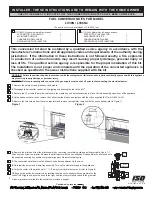
OPEL2 Owner's Manual
8
RSF Woodburning Fireplaces
FIRST FIRES
You will experience a slow start-up during the first few fires. The refractory bricks lining the firebox contain
moisture from manufacturing and require a few hot fires to evaporate the moisture. While there is still moisture in
the bricks, they will be black with smoke deposits. When the moisture has dissipated, the bricks will turn white.
Unlike cast iron stoves, there is no need to cure the fireplace itself by starting with small fires and progressively
larger ones. Feel free to light a large fire from the very start.
You will experience a slight odor during the first few fires. This odor comes from curing paint and oil burning off
the metal. The odor may be strong enough to set off your smoke detector. Open the doors and windows to allow
the room to properly ventilate.
Before the first fire, be absolutely sure to use regular dish soap and water to wipe off all fingerprints and
debris from the gold plating if you have chosen this option. The plating cures during this first fire, the
acid from your finger prints will permanently etch the gold plating.
LIGHTING
Ensure that the combustion air control lever is all the way in the open position. You will want as much air as
possible for the lighting process.
Start by laying your fire starter and kindling. Traditional fire starter is crumpled newspaper; make sure to use
enough to light the kindling (5-6 pieces should do). Next lay the kindling crisscrossed over the newspaper. Using
plenty of kindling ensures that the chimney will heat up quickly and establish a strong draft,
never use any
flammable liquids
. Light the paper and close the door most of the way, but don’t shut it completely. If the door is
positioned correctly you will see air rushing into the fireplace, this will help the lighting process.
Once the kindling is lit and sustaining fire, you can add some small pieces of seasoned cordwood. Use the
andirons in front to help position the cordwood so as not to flatten and smother the fire you’ve just created.
Always add at least 3 pieces of cordwood. Position your cordwood in a manner that the fire will hit several pieces
as it rises and has air gaps to flow through. Continue to leave the door slightly open until the cordwood is lit. Close
the door completely when the fire is established, if the fire goes out you’ve shut the door too early.
To get maximum efficiency out of your fireplace you will want to adjust the amount of air entering the firebox at the
appropriate times. Gauge how much to close the combustion air by how the fire reacts once the combustion air
control lever has been moved. If the fire goes out and begins to smolder, there’s too little combustion air entering
the firebox. If there’s no change to the burn pattern, you can continue to close the combustion air further.
Eventually you should be able to close the combustion air all or most of the way. There should always be visible
fire inside the firebox at every step of the process.
WARNING: DO NOT USE A GRATE OR ELEVATE THE FIRE.
REFUELING
The door should be opened slowly to keep smoke from spilling into your room. If you have a problem with smoke
spillage, check to see that all kitchen and bathroom fans have been shut off. They can cause negative pressure in
the house which pulls smoke out of the fireplace.
NOTE
: The central heat and internal blowers, if installed, should be shut off during refuelling to prevent smoke
from spilling out of the fireplace.
TROUBLESHOOTING PROBLEMS
If smoke comes into the house when the door is opened:
•
You may have opened the door too quickly and created a suction of air into the room, this can be avoided by
opening the door more slowly.
•
Ensure your chimney is clean and your chimney cap is not plugged. Chimney caps with screens are more
likely to become clogged with creosote buildup.
•
Make sure you have adequate chimney height for your system. Refer to the Chimney section of this booklet
and make sure to take altitude, and number of elbows into consideration.









































